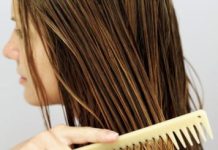Washing Hair correctly is far more than a simple lather-rinse-repeat cycle. It’s a foundational step in maintaining the health, vitality, and appearance of your locks. While it might seem like a mundane part of your routine, mastering the art of hair washing can dramatically transform your hair, addressing common issues like dryness, oiliness, frizz, and lack of shine. This comprehensive guide will walk you through every critical step, from prep to post-wash care, ensuring your hair gets the best possible treatment.

Table of Contents
Pre-Wash Rituals: Setting Your Hair Up for Success
Before you even turn on the faucet, a few minutes of preparation can make a significant difference.
- Detangle Thoroughly: Always brush or comb your hair before it gets wet. Wet hair is more fragile and prone to breakage. Gently detangling removes knots and snags, allowing for a more even shampoo application and preventing further tangles during the wash. Use a wide-tooth comb or a detangling brush, working from the ends upwards.
- Consider a Pre-Shampoo Treatment: For very dry, damaged, or color-treated hair, a pre-shampoo oil (like coconut or argan) or a treatment mask can offer an extra layer of protection and nourishment. Apply it to dry hair, leave it on for 15-30 minutes, and then proceed with your wash. This barrier can prevent too much moisture stripping from the shampoo.
- Adjust Water Temperature: Begin with lukewarm water. Water that’s too hot can strip your scalp of its natural oils, leading to dryness or, paradoxically, increased oil production. Lukewarm water opens the hair cuticles, allowing for effective cleansing and product absorption.
Mastering the Art of Shampooing for Effective Washing Hair
Shampooing isn’t just about suds; it’s about cleansing your scalp and hair without over-stripping it.
- Choose the Right Shampoo: This is paramount.
- Oily Scalp: Look for clarifying or balancing shampoos.
- Dry or Damaged Hair: Opt for moisturizing, hydrating, or repairing formulas.
- Fine Hair: Volumizing or lightweight shampoos work best.
- Thick/Coarse Hair: Rich, smoothing, or anti-frizz shampoos are ideal.
- Color-Treated Hair: Sulfite-free and color-safe formulas are a must to preserve vibrancy.
- Sensitive Scalp: Seek out gentle, fragrance-free, or hypoallergenic options.
- Use the Correct Amount: You don’t need a huge dollop. A coin-sized amount (quarter-sized for very long or thick hair) is usually sufficient. Over-shampooing can lead to unnecessary stripping.
- Lather in Your Hands First: Dispense the shampoo into your palms, add a little water, and rub your hands together to create a light lather. This ensures even distribution.
- Focus on the Scalp: The primary purpose of shampoo is to cleanse your scalp, where oil, product buildup, and dead skin cells accumulate. Gently massage the shampoo into your scalp with your fingertips, using circular motions. Avoid using your nails, which can scratch and irritate. Let the suds naturally run down the lengths of your hair as you rinse – there’s no need to aggressively scrub the ends, which are drier.
- Rinse Thoroughly: This is critical. Residual shampoo can weigh hair down, make it look dull, or cause scalp irritation. Rinse until the water runs completely clear and your hair feels squeaky clean.
Conditioning for Optimal Hydration and Softness
Conditioner restores moisture, smooths the cuticle, detangles, and adds shine, protecting your hair from environmental stressors.
- Select the Appropriate Conditioner: Just like shampoo, pick a conditioner tailored to your hair type and concerns (e.g., moisturizing, volumizing, color-protecting, repairing).
- Squeeze Out Excess Water: After rinsing shampoo, gently squeeze excess water from your hair. Conditioner dilutes in water, so applying it to soaking wet hair reduces its effectiveness.
- Apply from Mid-Lengths to Ends: Unless you have a specific scalp conditioner, focus on the parts of your hair that need moisture the most – the lengths and ends. Avoid applying rich conditioners directly to the scalp if you have fine or oily hair, as this can weigh it down or make it greasy.
- Leave it On: Give the conditioner time to work its magic. Refer to the product instructions, but typically 2-5 minutes is recommended. Use this time to shave, wash your body, or simply relax. For deeper conditioning, use a mask once a week.
- Rinse Smartly: Rinse your hair with cool or lukewarm water until it feels smooth but not necessarily “squeaky” clean. A slight slip can indicate some conditioning agents are left on, which is usually beneficial for most hair types. Cold water helps to close the hair cuticles, enhancing shine and sealing in moisture.
Post-Wash Care: Don’t Undo Your Hard Work
The way you treat your hair immediately after washing can significantly impact its health and appearance.
- Gentle Towel Drying: Ditch the rough rubbing. Instead, gently squeeze and blot your hair with a soft towel, ideally a microfiber one. Microfiber towels absorb more water and create less friction, reducing frizz and breakage. Aggressive rubbing can rough up the cuticle and lead to damage.
- Detangle Carefully: Once again, use a wide-tooth comb or a detangling brush specifically designed for wet hair. Start detangling from the ends and slowly work your way up to the roots to minimize pulling and breakage. A leave-in conditioner or detangling spray can make this process smoother.
- Apply Styling Products: This is the ideal time to apply any leave-in conditioners, heat protectants (if you plan to use heat styling), frizz-fighting serums, or volumizing mousses.
- Consider Air Drying: Whenever possible, allow your hair to air dry, or at least partial air dry, before using heat tools. This reduces heat exposure and stress on your strands.
Frequency of Washing: Find Your Perfect Rhythm
How often should you be washing hair? There’s no universal answer, as it depends on several factors:
- Hair Type: Oily hair might need daily washing, while dry or coarse hair can go 3-5 days.
- Scalp Health: Certain conditions may require specific washing frequencies.
- Activity Level: Workouts or humid climates can necessitate more frequent washes.
- Product Usage: Heavy styling product users might need to wash more often to remove buildup.
- Environment: Pollution or dust can make hair feel dirtier quicker.
Listen to your hair and scalp. If your hair feels greasy, heavy, or itchy, it’s time for a wash. Many people find success in “training” their hair to go longer between washes by gradually extending the time and using dry shampoo as needed.
Conclusion
Transforming your hair care routine starts with understanding the nuances of washing hair correctly. By selecting the right products, embracing proper techniques, and paying attention to your hair’s unique needs, you can unlock healthier, shinier, and more manageable locks. It’s an ongoing journey of discovery, but with these guidelines, you’re well on your way to giving your hair the expert care it deserves.






